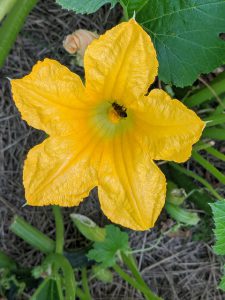By Sarah Bostick and Carol Wyatt-Evens
Gardening in Florida can be incredibly rewarding and incredibly frustrating, at the same time. If you are new to the region, you soon learn that gardening in the Sunshine State can quickly become a full-time job. While our subtropical climate is perfect for growing an abundance of different vegetables, fruits, and herbs, it also can present some overwhelming challenges.
We can help! UF/IFAS Extension Sarasota County agents and staff have created an online edible gardening resource center. The website features short videos from our 25-episode “Edible Gardening Series” webinars, along with blog posts and resources lists for episodes. Get help on an array of topics that befuddle many gardeners.
This week’s Question of the Week:
How do I make sure that the herbs and vegetables growing on my lanai are getting pollinated?
Growing edible plants in your lanai comes with a few unique challenges – all of them manageable with some pre-planning. One of those unique challenges is pollination. Because lanais are built to keep out insects such as mosquitoes, they are also very effective at keeping out pollinator insects such as bees.
Let’s start with a very brief lesson on plant reproduction. About 90% of all plant species on Earth produce flowers. Flowers are the reproductive structures of these plants. Most plants fall into one of two reproduction categories: cross pollinating and self-pollinating.

Cross pollination means that pollen from a flower on one plant is transferred to the flower on a different plant in the same species.
Self-pollination means that pollen is either transferred from one flower to another flower on single plant or that a flower contains both male and female parts and can literally pollinate itself.
When a flower is pollinated, the plant directs it energy into forming seeds. Many of our favorite foods produce a special structure around those newly forming seeds: fruit! Fruit is nature’s way of enticing creatures such as birds and humans to eat the fruit and “deposit” the seeds somewhere else. Most of the seeds held within fruits are quite large compared to seeds from plants that do not produce fleshy fruits.
Other plants do not put as much energy into the structure that contains their seeds. Many plants produce small, tight seedpods that burst open when mature, flinging their small seeds far and wide. Other plants produce seeds that are not held within a tight structure at all. These plants tend to produce very tiny seeds that are blown on the wind and carried by the flow of water after it rains.
So, how does all of this relate to the fruits, vegetables, and herbs you are growing on your lanai or other covered space? The easiest way to understand this topic is to break your edible plants into two categories:
- Plants that we eat the leaves, stems and roots of:
- If you are growing plants such lettuce, kale, basil, parsley, and radishes on your lanai, you don’t have to worry about pollination! We eat these plants in the non-flowering phase of their lifecycle.
- Plants that we eat the fruits of:
- Before we dive into this topic, it is important to note that fruiting vegetables such as tomatoes, peppers, eggplant, cucumbers, and squash may not receive enough sunlight in your lanai to thrive. This link will help you decide if your lanai or other covered space receives enough direct sunlight to meet the needs of these sun-loving crops.
- If you think that your lanai receives enough light for tomatoes, peppers, eggplant, cucumbers, and squash, here is what you need to know about pollination:
- Peppers, eggplant, and tomatoes are self-pollinating! In an outdoor setting, these three plants rely on wind and the vibration caused by bees landing on flowers to knock pollen off of one flower and onto another flower on the same plant or a nearby plant. Because lanais keep out bees and wind, your peppers, eggplant, and tomatoes will benefit from your help. Every day or two during the span of time that your plants are flowering, gently shake each plant. This will release pollen that will float through the air and land on nearby flowers.
- Cucumbers and squash require cross-pollination. Most varieties of cucumbers and squash rely on bees to produce fruit. Gently shaking the plant will not aid in pollination. But you can still produce cucumbers and squash in a lanai! Here are the two options doing this:

Newly forming cucumber with flower still attached. - Option 1: use a small, water-color paintbrush to brush pollen from the male flowers of one cucumber plant onto the female flowers of another cucumber plant. You can do the same for squash. This document will teach you to recognize male and female flowers and how to hand-pollinate.
- Option 2: purchase a “parthenocarpic” variety of cucumber or squash. Parthenocarpic is a fancy term that simply means that a plant can make fruit without a flower being pollinated. Parthenocarpic fruit is mostly or completely seedless.
The Edible Gardening Series and blog series is a partnership between the following UF/IFAS agents and Sarasota County staff:
- Sarah Bostick, Sustainable Agriculture Agent
- Carol Wyatt-Evens, Chemicals in the Environment Agent
- Mindy Hanak, Community & School Gardens Educator
- Kevin O’Horan, Communications Associate
 0
0

